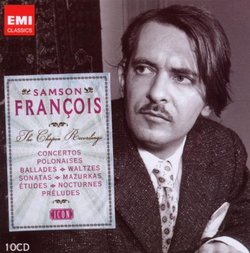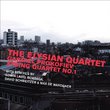| All Artists: Samson Francois Title: Icon Members Wishing: 0 Total Copies: 0 Label: EMI Classics Original Release Date: 1/1/2010 Re-Release Date: 6/8/2010 Genre: Classical Styles: Historical Periods, Classical (c.1770-1830) Number of Discs: 10 SwapaCD Credits: 10 UPC: 5099945535727 |
Search - Samson Francois :: Icon
 | Samson Francois Icon Genre: Classical
Samson's early recordings, dating from the end of the 1940s, were mainly devoted to Frédéric Chopin, who already occupied a prominent position in his concert programmes. The height of Samson's art is probably to... more » |
Larger Image |
CD Details
Synopsis
Album Description
Samson's early recordings, dating from the end of the 1940s, were mainly devoted to Frédéric Chopin, who already occupied a prominent position in his concert programmes. The height of Samson's art is probably to be found in the ballades (recorded between 26 and 28 October 1954, and first issued as an immensely successful 10" LP) and the dazzling interpretation of the nocturnes (recorded in May and June 1966). In the ballades and the nocturnes Samson establishes an all-embracing colour with the aid of the loud pedal, although he modulates its power and creates a rainbow effect through the highly skilled, yet quite unpredictable use of the soft pedal. This alternation between the two pedals gives a breathless feeling to his approach. You will never find there the peaceful, semi-philosophical havens, nor the "landscaped" perspectives of neo-Classical pastoralism favoured by so many of his fellow artists, notably in the Fourth Ballade. Samson strikes a balance between the visual and the narrative. The harmonic suspensions, which form the nub of the ballades, seem as if they are absorbed by this visionary ability, and all that preceded and all that followed could only be narration. Rarely have other pianists taken a similar view, and only Claudio Arrau - in his legendary first recording of the ballades made in 1953 - evolved within this perspective. The nocturnes, recorded twelve years later, in 1966, possess the same burnished colour that characterises a Rembrandt background, despite the more analytical clarity cast by stereo sound. Once again it is Arrau, who, by voluntarily darkening his range of colours, seems to come nearest to this sultry vision of the nocturnes, while another leading interpreter of the cycle, the Polish pianist Stefan Askenase, was to fix his gaze obstinately in the direction of moonlight and the bel canto aesthetic. If we are to go by the history of gramophone recording, no other pianist before him had discovered the personal, inimitable accent which Samson gives to the melodic pattern of these works, and which was not to be taken up by any other: over-intimate, perhaps, or over-rhapsodic, it is stylistically close to improvisation. If Samson still seems to be following a given declamatory scheme in the ballades, then the range of styles and expressiveness which he deploys for the abundant inventiveness of the nocturnes, has nothing to do with the innermost nature of the interpreter. For a good decade, Samson did not go back on his beliefs: he reinforced them. Samson's life was abruptly cut short in 1970 at a ridiculously early age - he was 46. Neither as pupil nor as teacher did he have any interest in pedagogy. Was this because he chose to keep his distance from all relationship or dependency? There is something of the stateless person in Samson's pianistic style. Furthermore, it seems very difficult to compare his art with that of other pianists. However, those French pianists of the new generation who have rediscovered Chopin (in large part thanks to Samson's recordings), would seem to be in his debt.
Similar CDs
| Eliane Radigue Vice Versa, Etc. Genres: Special Interest, Pop, Rock Label: Important Records | |

 Track Listings (6) - Disc #1
Track Listings (6) - Disc #1


